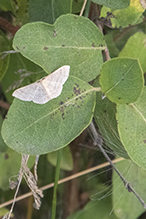Simple wave
(Scopula junctaria)
Conservation • Description • Habitat • Ecology • Distribution • Taxonomy
| Hodges # | 7164 |
||
Conservation Status |
|||
| IUCN Red List | not listed |
||
| NatureServe | NNR - Unranked |
||
| Minnesota | not listed |
||
Description |
With about 500 described species worldwide, Scopula is the largest genus in the subfamily Sterrhinae (waves and mochas). At least 30 occur in North America north of Mexico. The genus also contains some of the largest and most common species of the family Sterrhinae in North America. Simple wave is a small geometer moth. It occurs across the United States, Canada, and Mexico. Adults have a wingspan of ¾″ to 1″ (20 to 26 mm). They are variable in both the shape of the forewings and its overall color. The forewings may be sharply angled or rounded at the tip. The overall color may be white or dingy yellowish (cream-colored). All individuals have a dusting of dark scales on the forewings and hindwings. There are at least three dark, thin, wavy lines: the antemedial line (AM line), between the basal and median areas; the median line, which passes through the median area; and the postmedial line (PM line), that separates the median area from the postmedial area. On cream-colored individuals, there is also visible an adterminal line, just before the terminal area; and a subterminal line (ST line), between the PM line and the adterminal line. Lines on cream-colored individuals are brownish-yellow and easily discernible. Lines on white individuals are faint. The AM, median, and PM lines are sightly sinuous, are complete from the inner to the forward (costal) margins, and curve up approaching the costal margin. On white individuals the ST and adterminal lines are present but may be difficult to see. There is usually no discal spot. The hindwing is similar but there is no AM line. |
Size |
Wingspan: ¾″ to 1″ (20 to 26 mm) |
Similar Species |
Habitat |
|
Ecology |
Season |
One generation per year: Late May to August |
Behavior |
The wings are spread out and appressed to the leaf or other substrate when at rest. In this position, the leading edges of the wings (costas) form a nearly straight line. |
Life Cycle |
|
Larva Hosts |
Leaves of forbs and deciduous trees and shrubs, including chickweed, elm, and clover |
Adult Food |
|
Distribution |
||
|
Sources Biodiversity occurrence data published by: Minnesota Biodiversity Atlas (accessed through the Minnesota Biodiversity Atlas Portal, bellatlas.umn.edu, 8/31/2025). |
|
| 8/31/2025 | ||
Occurrence |
||
|
||
Taxonomy |
|
Order |
|
Superfamily |
Geometroidea (Geometrid and Swallowtail Moths) |
Family |
|
Subfamily |
Sterrhinae (waves and mochas) |
Tribe |
Scopulini |
Genus |
Scopula |
Subordinate Taxa |
|
simple wave (Scopula junctaria johnstonaria) simple wave (Scopula junctaria junctaria) simple wave (Scopula junctaria quinquelinearia) |
|
Synonyms |
|
Acidalia junctaria |
|
Common Names |
|
simple wave simple wave moth |
|
Glossary
Antemedial line
A thin line separating the basal area and the median area of the forewing of Lepidoptera.
Costal margin
The leading edge of the forewing of insects.
Visitor Photos |
Share your photo of this insect. |
||
This button not working for you? |
||
Lynn Rubey |
 |
A Simple Wave Moth in The Big Stone National Wildlife Refuge. |
MinnesotaSeasons.com Photos |
|

Slideshows |
|

Visitor Videos |
Share your video of this insect. |
||
This button not working for you? |
||
|
Other Videos |
|

Visitor Sightings |
Report a sighting of this insect. |
||
This button not working for you? |
||
Lynn Rubey
8/13/2019
Location: Big Stone National Wildlife Refuge
A Simple Wave Moth in The Big Stone National Wildlife Refuge.
MinnesotaSeasons.com Sightings |
|

|
Created: 8/27/2019 Last Updated: © MinnesotaSeasons.com. All rights reserved. |

